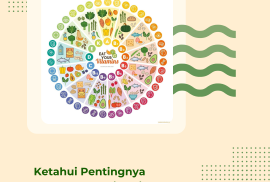Nowadays, the rapid development of science and technology is felt in various sectors, including nutrition and health. The concept of a medical paradigm through a predictive, preventive, personal, and participatory approach can manage and support a specific health status for individuals. Personalized nutrition is a basic concept that shows everyone has a different metabolism, genetics, biochemistry, and microbiota that contribute to the body’s response to nutritional intake. Therefore, the concept of personalized nutrition applies multidisciplinary, such as nutrition, medicine, biology, epigenetics, and genomics to demonstrate the relationship of individual variation to a disease risk.
Education
Recently people are familiar and connected with the science and technology development especially in the health area. In health area, technology has been widely used in such areas as communication, education, and health management. Besides that, technology has also been widely used for diet management, food nutrition database, and anthropometrics measurements. Technological applications in the field of nutrition have now entered a “genomic era” that relates to the development of nutrigenetic. Nutrigenetic is science that studies the interaction between the genetic impact and nutrition in specific individuals. The relationship between genes and individual nutrition intake is specifically known by the term personalized nutrition. The term has broken the old approach called “one size fit all” which means the nutritional needs are united for everyone.
Sugar-sweetened beverages (SSB) are any type of drinks that are sweetened with added sugars, such as brown sugar, corn sweetener, corn syrup, dextrose, fructose, glucose, high-fructose corn syrup, honey, lactose, malt syrup, maltose, raw sugar, and sucrose (1,6). This includes, but are not limited to, regular soda, fruit drinks, sports drinks, energy drinks, sweetened waters, also coffee and tea beverages with added sugars (1). SSB usually contains high calories but it will not make you feel as full as if you had eaten the same calories from solid food. There is a research (2) that explained about sugar content of SSB per serving of product in Indonesia by sampling 91 SSB products from a popular convenience store. On an average, the amount of sugar per serving was 22.8 g or 86.3 g/1000 ml. Sugar in sports drinks had the highest contribution to energy of products (93.33%).
The case of the Omicron variant of COVID-19 is still the main case in Indonesia. On February 19, 2022, known daily cases reached 59.384, higher than last year’s peak of Delta’s daily cases of 56.757. However, the Ministry of Health stated that there was a decrease in daily confirmed cases of 10.900 on February 20 from the previous day, and active cases slowed slightly with the addition of 15.448 per day. Nevertheless, the government continues to make efforts to prevent the COVID-19 pandemic by increasing the complete vaccination program and booster doses. If someone has received the second dose within a minimum period of six months, it is strongly recommended to get a booster vaccination (Kemenkes, 2022). Several studies have shown that booster vaccines are considered to be more effective in preventing transmission of the Omicron variant of COVID-19 than the Delta variant (Omer and Malani, 2022).
COVID-19 daily cases in Indonesia will continue to climb due to the omicron variant’s transmission, approaching the delta variant’s peak in mid-2021. The daily adding positive confirmation of 55,209 cases on February 13, 2022. According to WHO (2022), the omicron variant has higher infection rates but a mortality rate lower than a delta variant. The Director of Infectious Disease Prevention and Control of The Health Ministry Indonesia predicted the peak of the COVID-19 variant omicron case in early March 2022. Therefore, communities need to increase preventive measures in the COVID -19 infection by guarding medical protocol, performing booster vaccinations, and increasing body immunity.
Malnutrition refers to deficiencies, excesses, or imbalances of someone’s energy and/or nutrients intake. It’s divided into 2 broad groups of conditions, i.e. undernutrition and overnutrition. Monitoring body weight regularly could help to maintain normal body weight and prevent malnutrition.
Based on World Health Organization, obesity is defined as excessive fat accumulation that presents a higher risk of comorbidity and mortality. Comorbid can affect someone’s quality of life. Some of those comorbid risks are:
Because of COVID-19 pandemic, social activities are restricted. People work from home, so our daily physical activities are minimal. For example, we just sitting for hours in front of a computer or laptop. However, physical activity needs to be done at least 30 minutes, routinely 3-5 times a week (Ministry of Health, 2020).
According to the Community Promotion and Empowerment Section (2020) physical activity, including exercise, are needed to:
- Reduces anxiety
- Control stress
- Control cholesterol levels
- Improve joint flexibility and muscle strength
- Increase endurance and the immune system
We need to do regular physical activity to improve physical fitness, maintain ideal body weight, and prevent obesity (Promotion and Community Empowerment Section, 2020). In carrying out daily activities during a pandemic, we need to stretch every two hours for 10-15 seconds. Besides, we also need to regularly drink water to avoid dehydration and avoid smoking (Abdulloh, 2020)
Infectious diseases are one of the factors that affect a person’s nutritional status, both children and adults. Nutritional status has an influence on the immune system and the healing process. A person with a poor or even poor nutritional status is more at risk of developing various diseases and the healing time tends to be slower. Someone who is infected with an infectious disease needs more nutritional intake but has a problem, namely a decreased appetite. This can lead to weight loss and worsening nutritional status (Putri,2015).
We really need a variety of foods because there is no single type of food that contains complete nutrition except breast milk. For example, rice is a major source of calories, but is poor in vitamins and minerals; vegetables and fruits are generally rich in vitamins, minerals, and fiber, but poor in calories and protein; fish is a major source of protein but few calories. Therefore, consuming a variety of foods is absolutely necessary for us to keep our bodies healthy.
In the principle of consuming diverse foods, the proportion of food consumed must also be considered so that it is balanced, in sufficient quantities, not excessive, and carried out regularly. The variety of foods in balanced nutrition is clearly shown in the ”tumpeng gizi seimbang” or Healthy Food Pyramid. “Tumpeng Gizi Seimbang” consists of several tumpeng pieces: one large slice, two medium pieces, two small pieces, and at the top there are the smallest pieces. The width of the tumpeng pieces indicates the portion of food that each person should consume per day.





